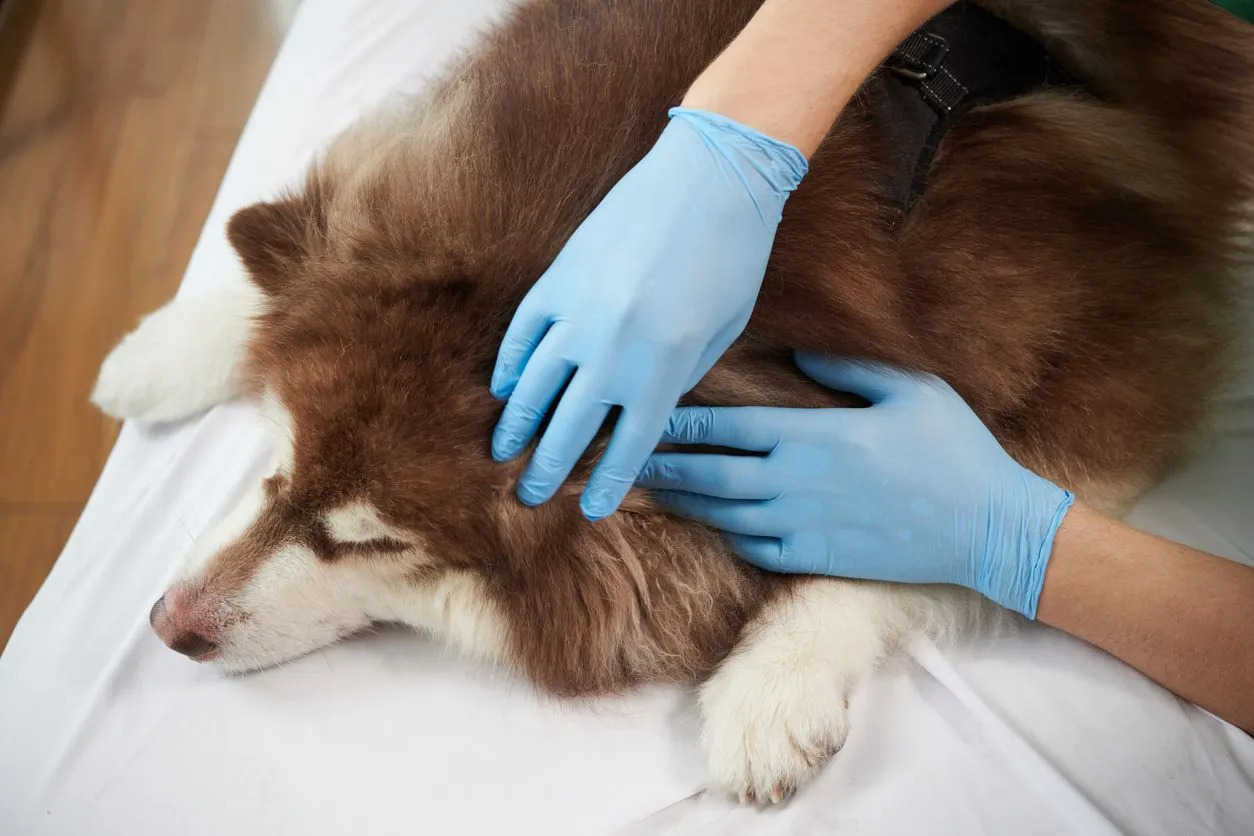Home>Health & Wellness>Common Health Issues>Why Does My Dog Only Have Allergies In September?


Common Health Issues
Why Does My Dog Only Have Allergies In September?
Published: January 26, 2024
Discover the reasons behind common health issues in dogs, including allergies, and why they may be more prevalent in September. Learn how to manage your pet's health during this time of year.
(Many of the links in this article redirect to a specific reviewed product. Your purchase of these products through affiliate links helps to generate commission for Pawsomeoldies.com, at no extra cost. Learn more)
Table of Contents
Introduction
Seasonal allergies in dogs can be a perplexing and frustrating issue for pet owners. You might have noticed that your furry friend starts exhibiting allergy symptoms like itching, scratching, and sneezing, but only during certain times of the year, such as September. This peculiar pattern can leave you wondering why your dog seems to be perfectly fine for most of the year, only to be plagued by allergies during a specific month.
Understanding the underlying reasons behind your dog's seasonal allergies is crucial in providing the best care and relief for your beloved pet. While it may seem like a mystery, there are logical explanations for this phenomenon. By delving into the factors that contribute to your dog's allergies, you can gain valuable insights into how to manage and alleviate their discomfort.
In this article, we will explore the intriguing world of seasonal allergies in dogs, shedding light on why these allergies tend to flare up during specific months, such as September. We will delve into the environmental triggers that are prevalent during this time of the year and provide practical tips for managing your dog's allergies effectively. By the end of this article, you will have a deeper understanding of your dog's seasonal allergies and be equipped with the knowledge to support them through their allergy-prone months.
Read more: Why Does My Dog Have A Bump By Her Eye
Understanding Seasonal Allergies in Dogs
Seasonal allergies in dogs, also known as atopic dermatitis, are akin to the hay fever experienced by humans. These allergies are triggered by environmental factors that are only present during certain times of the year. The most common culprits behind seasonal allergies in dogs are pollen, mold, and dust mites. When these allergens come into contact with a susceptible dog, they can trigger an immune system response, leading to a range of uncomfortable symptoms.
Dogs with seasonal allergies often exhibit signs such as incessant itching, scratching, licking, and chewing, particularly around their paws, ears, and abdomen. Additionally, they may experience skin redness, inflammation, and recurrent ear infections. These symptoms can significantly impact a dog's quality of life, causing distress and discomfort.
The timing of these allergies is often linked to the fluctuation of environmental allergens throughout the year. For instance, in September, many regions experience a surge in pollen levels as certain plants reach their peak flowering season. This increase in pollen can spell trouble for dogs with pollen allergies, triggering a cascade of allergic reactions.
It's important to note that while seasonal allergies tend to manifest during specific months, they can vary depending on geographic location and local environmental conditions. Factors such as temperature, humidity, and vegetation cycles play a role in determining when allergens are most prevalent, thereby influencing the timing of seasonal allergies in dogs.
Understanding the seasonal nature of these allergies is crucial for pet owners, as it allows them to anticipate and prepare for potential flare-ups. By recognizing the patterns of allergen exposure and their impact on their dog's well-being, owners can take proactive measures to mitigate the effects of seasonal allergies and provide relief for their furry companions.
In the next section, we will delve into the specific environmental triggers that make September a challenging month for dogs with seasonal allergies, shedding light on the factors that contribute to their discomfort during this time of the year.
Environmental Triggers in September
September heralds the transition from summer to fall, bringing about a unique set of environmental triggers that can exacerbate seasonal allergies in dogs. Understanding these triggers is essential for pet owners seeking to alleviate their furry companions' discomfort during this challenging month.
One of the primary environmental triggers in September is the surge in pollen levels. As summer gives way to autumn, numerous plants enter their peak flowering season, releasing copious amounts of pollen into the air. This pollen serves as a potent allergen for dogs predisposed to pollen allergies, triggering a range of allergic reactions. Common pollen sources in September include ragweed, sagebrush, and various grasses, all of which can wreak havoc on sensitive canine immune systems.
In addition to pollen, mold spores become increasingly prevalent in September, particularly in regions with higher humidity levels. Damp and decaying organic matter provides an ideal breeding ground for mold, leading to heightened spore release during this time of the year. Dogs with mold allergies may experience exacerbated symptoms, including respiratory distress and skin irritation, as a result of heightened mold spore exposure in September.
Furthermore, dust mites, microscopic arachnids that thrive in warm and humid environments, pose a persistent threat to dogs with allergies, especially in September. As temperatures begin to cool, indoor environments may become more conducive to dust mite proliferation, leading to increased exposure for dogs spending time indoors. This uptick in dust mite activity can exacerbate allergic reactions, manifesting as itching, sneezing, and respiratory issues in affected dogs.
The combination of these environmental triggers creates a perfect storm for dogs with seasonal allergies in September. The simultaneous presence of pollen, mold spores, and dust mites poses a formidable challenge for pet owners striving to manage their dogs' allergy symptoms during this time of the year.
Understanding these environmental triggers empowers pet owners to take proactive measures to minimize their dogs' exposure to allergens in September. By implementing strategies such as regular grooming to remove pollen from the coat, keeping indoor environments clean and well-ventilated to reduce mold and dust mite proliferation, and utilizing air purifiers to filter out airborne allergens, pet owners can significantly alleviate their dogs' allergy-related discomfort during this challenging month.
By recognizing and addressing the specific environmental triggers that make September a difficult period for dogs with seasonal allergies, pet owners can provide targeted support for their furry companions, ultimately enhancing their well-being and quality of life.
Managing Your Dog's Allergies in September
Managing your dog's allergies in September requires a proactive and multifaceted approach to minimize their exposure to environmental triggers and alleviate their allergy-related symptoms. By implementing targeted strategies and incorporating preventive measures, pet owners can effectively support their furry companions through this challenging month.
Regular grooming plays a pivotal role in managing your dog's allergies in September. Frequent bathing and brushing help remove pollen and other allergens from your dog's coat, preventing these irritants from lingering and triggering allergic reactions. Additionally, wiping your dog's paws and fur after outdoor excursions can further reduce their allergen exposure, contributing to overall symptom relief.
Maintaining a clean indoor environment is equally crucial in managing your dog's allergies during September. Regular vacuuming, dusting, and washing of bedding can help minimize the presence of dust mites and indoor mold, reducing potential allergen exposure for your dog. Furthermore, utilizing air purifiers equipped with HEPA filters can effectively capture airborne allergens, creating a more allergen-free living space for your furry friend.
Dietary considerations also play a significant role in managing your dog's allergies in September. Opting for high-quality, hypoallergenic dog food can help mitigate allergic reactions, as certain ingredients in standard dog food may exacerbate allergy symptoms. Consultation with a veterinarian to explore potential dietary adjustments tailored to your dog's specific allergies can yield valuable insights and contribute to symptom management.
In addition to these proactive measures, seeking professional guidance from a veterinarian is essential for effectively managing your dog's allergies in September. Veterinarians can provide personalized treatment plans, including allergy medications, immunotherapy, and topical treatments to alleviate your dog's symptoms and improve their overall comfort. Furthermore, veterinarians can conduct allergy testing to identify specific allergens affecting your dog, enabling targeted management strategies.
Lastly, maintaining open communication with your veterinarian and closely monitoring your dog's response to management efforts are crucial aspects of effectively navigating their allergies in September. By staying attuned to your dog's behavior, symptoms, and overall well-being, you can make informed adjustments to their care plan, ensuring that they receive the most effective support throughout this challenging month.
By integrating these proactive measures, seeking professional guidance, and maintaining attentive care, pet owners can effectively manage their dog's allergies in September, providing them with the relief and support they need to thrive despite seasonal allergen challenges.
Conclusion
In conclusion, understanding why your dog experiences allergies specifically in September is pivotal in providing the best care and relief for your furry companion. The seasonal nature of these allergies, driven by environmental triggers such as pollen, mold spores, and dust mites, sheds light on the challenges that dogs face during this time of the year. By recognizing these triggers and their impact on your dog's well-being, you can take proactive steps to manage their allergies effectively.
As September brings a surge in pollen levels, particularly from plants entering their peak flowering season, dogs with pollen allergies are especially susceptible to heightened allergic reactions. Additionally, the increased prevalence of mold spores and dust mites in September poses additional challenges for dogs with environmental allergies, exacerbating their symptoms and discomfort.
To support your dog through their allergy-prone month, proactive measures such as regular grooming to remove allergens, maintaining a clean indoor environment, dietary considerations, and seeking professional guidance from a veterinarian are essential. By integrating these strategies and staying attuned to your dog's needs, you can effectively manage their allergies and provide them with the relief and support they need to thrive despite seasonal allergen challenges.
Ultimately, by gaining a deeper understanding of your dog's seasonal allergies and the specific environmental triggers prevalent in September, you can empower yourself to be a proactive and attentive caregiver. Through targeted management strategies and a commitment to your dog's well-being, you can navigate their allergies with confidence, ensuring that they receive the best possible care during this challenging time of the year.















